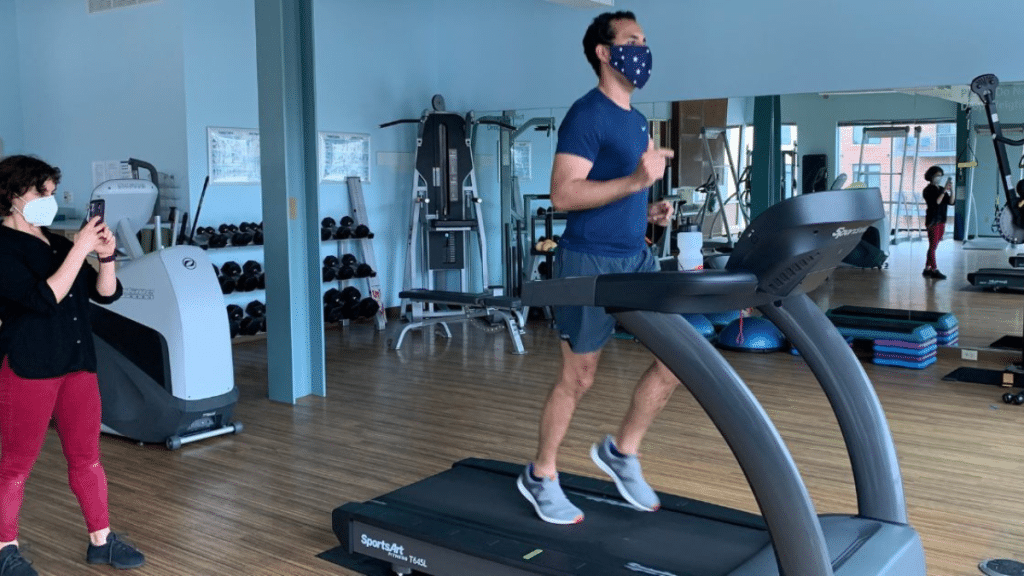Why Gait Analysis Matters
Many runners train hard yet still have sore knees or tight calves. They blame age, shoes, or bad luck. A close look at how each foot hits the ground can change that story. Gait analysis turns video and force data into clear fixes that boost speed and protect joints.
How The Process Works
A gait study starts with a few minutes on a treadmill. Cameras record every stride from many angles. Small markers on hips, knees, and heels help track joint lines. Pressure plates measure force at each step. A screen shows where load hits hard and where form wastes energy.
Expert Eyes vs. Guesswork
Coaches once guessed stride faults by eye and shouted tips on the fly. Motion capture removes the guesswork. At Precision Sports Physical Therapy in East Dallas, staff play each runner’s video frame by frame. They freeze when the lead foot lands to show if it’s under the hips or too far in front. Over-striding slows you down and adds braking force. A shorter stride that lands closer to center often saves energy and reduces shock.
Hip Control For Knee Health
Hip control drives knee health. Weak glute muscles let the hip drop when your foot strikes. The knee then caves in, putting strain on tendons. Video shows that drop clearly. Therapists note the change after a few weeks of hip work. Stronger hips line up the knee and reduce angles that cause IT band pain.
Managing Impact Forces
Ground forces can be several times body weight during fast runs. Force graphs show this as a mountain shape. By changing cadence, runners spread that load over more time, turning the mountain into a hill. Just five more strides per minute often smooths the curve and lowers shock. Seeing the peak fall on screen makes the change clear.
Picking The Right Shoes
Shoes matter, but no brand fixes bad form alone. A gait study helps pick soles that match your strike pattern and arch. A heel striker may need more rear cushion; a midfoot runner wants softer front foam. Some switch shoes between long runs and speed days. The report shows which pair keeps forces low. This simple change often stops arch or Achilles pain.
Speed Benefits
Gait tweaks also improve race times. Less bounce means each stride pushes forward, not up. Smooth hip drive turns foot turnover into easy speed. Runners who cut ground time by even a tiny bit each step save minutes over a marathon. They finish strong rather than limping in the final miles.
Injury Prevention
Injury risk drops when form wastes less force. Stress breaks happen where bone takes the same peak load over and over. A stride fix spreads load, letting bone rebuild between runs. Tendons heal the same way. The body does better with varied stress, not repeat blows. Gait analysis guides safe changes.
Young Athlete Advantage
Young athletes gain a head start. Early video shows habits before miles set them in place. Learning good foot strikes and steady hips in high school helps through adult life. Coaches who add analysis to early checks can plan drills that prevent bad patterns.
Older Runner Solutions
Older runners face changes too. Age brings less ankle flex and weaker calf push. Force graphs show longer ground times and higher peaks. Strength and stretch work, based on the report, bring back some lost spring. Runners often feel years younger after a month of steady work.
Arm Swing Matters
One common fault hides in arm swing. Hands that cross the middle twist the torso and waste drive. Video spots this and links it with side-to-side force spikes. A cue to keep thumbs near the hips sets the arms in line. The runner feels smoother within two sessions.
Effective Warm-Up Drills
Warm-up drills feed new form into muscle memory. Skips, high knees, and kicks prime hip flexors and hamstrings. Runners use the drills from their report before each workout. Over time, new patterns stick even when tired in late races.
Tracking Your Progress
Data also tracks progress. A second test after six weeks shows new angles and smaller peaks. Seeing the change keeps runners driven and guides more tweaks. Some labs use force plates again at three months to lock in gains.
Getting Access To Analysis
Cost keeps dropping as tech spreads. Many clinics run group days at local tracks with portable gear. Apps now record decent slow-motion from phones, though lab gear still offers better force data. Either way, the first step is clear: film, measure, act.
Working With Experts
Therapists at Precision Sports turn each report into a short action plan. They write strength sets, drill lists, and shoe tips in plain words. Runners leave with more than charts; they get a roadmap. Follow-ups check progress and refine cues. This data-driven care makes form change less random.
Making Gradual Changes
Some fear that changing stride will feel odd or cause new pain. Slow work prevents this. Runners start with short form strides in warm-ups, then use the new style in easy runs. Speed days keep old form until the body adapts. Within a month, the change feels natural and pace returns.
The Bigger Picture
Running stays simple at its core. Lace up, head out, breathe. Yet simple doesn’t mean crude. Small details decide if miles build strength or cause injury. A motion study shines light on those details. Stride length shortens where it once reached too far. Ground force smooths where it once spiked. Hips level out, arms drive straight, shoes match strike. Each piece adds up to longer, safer running.
The main gait analysis benefits are clear view and targeted change. Runners stop guessing why knees hurt and start seeing why on screen. Small tweaks spread forces, steady hips, and align feet. Labs like Precision Sports provide the tools that turn slow-motion clips into useful steps. With data and time, runners can hit the road sure that each stride works with them, not against them.
